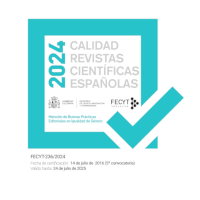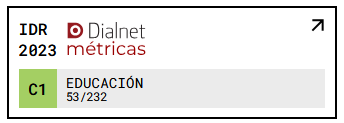El pensamiento docente y su influencia en la implantación de las tecnologías de la información y la comunicación en el aula : Desafíos y oportunidades
DOI:
https://doi.org/10.18172/con.640Palabras clave:
Pensamiento docente, Tecnologías de la información y de la comunicación, profesorado, actitudes, creenciasResumen
Un reto fundamental de la educación actual es la implantación de las tecnologías de la información y comunicación (TICs de aquí en adelante) en las instituciones educativas para mejorar la gestión y especialmente, la calidad del proceso de enseñanza-aprendizaje. Este artículo pretende analizar las dificultades y obstáculos –primarios y secundarios– existentes en su implantación, focalizando la atención en el pensamiento docente al considerarse un factor clave. Se parte de un análisis general de la estructura y funcionamiento del pensamiento docente centrado en las actitudes, creencias y expectativas, valorando su influencia en la integración de las TICs. Las conclusiones apuntan la necesidad de dotar a los docentes de una visión positiva ante el uso de las TICs en una serie de propuestas que faciliten su progresiva implantación.Descargas
Citas
Abrami, P. C. (2001). Understanding and promoting complex learning using technology. Educational Research and Evaluation, 7, 113-136.
Al-Senaidi, S., Lin, L. y Poirot, J. (2009). Barriers to adopting technology for teaching and learning in Oman. Computers & Education, 53, 575-590.
Angeli, C. y Valanides, N. (2009). Epistemological and methodological issues for the conceptualization, development, and assessment of ICT–TPCK: Advances in technological pedagogical content knowledge (TPCK). Computers & Education, 52, 154-168.
Arranz, P. (2002a). Representaciones mentales del profesorado respecto al Síndrome de Down: Implicaciones para un cambio en los modelos de formación. En S. Molina, Psicopedagogía del niño con síndrome de Down (pp. 299-354). Maracena, Granada: Arial.
Arranz, P. (2002b). Las representaciones mentales de los maestros en ejercicio y en formación respecto al síndrome de Down. Tesis doctoral inédita. Universidad de Zaragoza.
Bandura, A. (1987) Pensamiento y Acción. Barcelona: Martínez Roca.
Bandura, A. (1997). Self-efficacy: The exercise of control. New York, NY: Freeman.
Baylor, A. y Ritchie, D. (2002). What factors facilitate teacher skill, teacher morale, and perceived student learning in technology-using classrooms? Computers & Education 39(1), 395-414.
Bloch, S. y Maturana, H. (1996). Biología del Emocionar y Alba Emoting, Bailando Juntos. Santiago de Chile: Dolmen.
Cabero, J. (2001). Utilización de recursos y medios en los procesos de enseñanza-aprendizaje. En Actas de las IV Jornadas Nacionales de Desarrollo Curricular, Organizativo profesional. Jaén.
Cabero, J. (2008). TICs para la igualdad: la brecha digital en la discapacidad. Anales de la Universidad Metropolitana, 8(2), 15-43
Caracena, J. M. (2007). La identidad virtual y el trabajo colaborativo en red como bases para el cambio de paradigma en la formación permanente del profesorado. Revista DIM: Didáctica, Innovación y Multimedia, 10.
Ching, S. y Huang, Y.-F. (2008). A study of high school English teacher´s behavior, concerns and beliefs in integrating information technology into English instruction. Computers in human behavior, 24(3), 1085-1103.
Devos, G., Bouckenooghe, D., Engels, N., Hotton, G. y Aelterman, A. (2007). An assessment of well-being of principals in Flemish primary schools. Journal of Educational Administration, 45, 33-61.
Doomekamp, B. (1994). A implementaçao de Computadores no Ensino Secundario: O exemplo da Holanda. Revista da Escola Superior de Educaçao de Portoalegre, 16, 102-114.
Ertmer, P. (1999). Examining teachers’ beliefs about the role of technology in the elementary classroom. Journal of Research on Computing in Education, 32, 54-72.
Esteban, M. (2005). La Educación Permanente y las Nuevas Tecnologías ante las necesidades educativas actuales. Quaderns digitals. Monográfico educación comparada, 38, 1-9.
Gialamas, V. y Nikolopoulou, K. (2010). In-service and pre-service early childhood teachers’ views and intentions about ICT use in early childhood settings: A comparative study. Computers & Education (Articulo en prensa) .
Gilster, P. (1997). Digital Literacy. New York: Wiley Computer Publishing.
Gisbert, M. (2000). El profesor del siglo XXI: De transmisor de contenidos a guía del ciberespacio. En Cabero et al. (Coords.), Y continuamos avanzando. Las nuevas tecnologías para la mejora educativa (pp. 315-330). Sevilla: Kronos.
Gómez, J., Mur, J. y Sanz, J. (2010). Redes Sociales en educación: El camino hacia la escuela 2.0. Actas del II Congreso Galego de Investigación en Ciencias da Educación. Santiago de Compostela.
González, A. P. (1998). Más allá del curriculum: La educación ante el reto de las nuevas tecnologías de la información y la comunicación. Universitas Tarraconensis: Revista De Ciències De l'Educació, 22, 151-162.
Hawkridge, D. (1990). Who needs computers in school, and why? Computers and Education, 15, 1-6.
Hervás, C. y Martín, J. (1997). Evaluación de necesidades formativas, actitudes y creencias del profesorado de Educación Secundaria. Revista Electrónica Interuniversitaria de Formación del Profesorado, 1(0).
Hoban, G. (2002). Teacher learning for educational change. Buckingham: Open University Press.
Hughes, M. y Zachariah, S. (2001). An investigation into the relationship between effective administrative leadership styles and the use of technology. International Electronic Journal for Leadership in Learning, 5, 1-10.
Hulpia, H. y Valcke, M. (2004). The use of performance indicators in a school improvement policy: The theoretical and empirical context. Evaluation & Research in Education, 18, 102-120.
Iglesias, F., Veiga, E. y Gonzalez, M. (2000). Actitudes del profesorado de primaria hacia la informática: un estudio exploratorio. V Congreso Galego-Portugués de Psicopedagoxía Actas (Comunicacións e Posters), 6(4), 258-265.
Lajoie, S. P. (2003). Individual differences in spatial ability: developing technologies to increase strategy awareness and skills. Educational Psychologist, 38, 115-125.
Li-Ping, T. y Austin, M. J. (2009). Students’ perceptions of teaching technologies, application of technologies, and academic performance. Computers & Education, 53, 1241-1255.
Mac Beath, J. (1999). Schools Must Speak for Themselves: the Case for School Self-evaluation. London: Routledge.
Marqués, P. (2008). El impacto de las TIC en educación: funciones y limitaciones. Recuperado de: http://peremarques.pangea.org/siyedu.htm.
Mueller, J., Wood, E., Willoughby, T., Ross, C. y Specht, J. (2008). Identifying discriminating variables between teachers who fully integrate computers and teachers with limited integration. Computers & Education, 51, 1523-1537.
Murphy, C. A., Coover, D. y Owen, S. V. (1989). Development and validation of the computer self-efficacy scale. Educational and Pyschological Measurement, 49, 893-899.
Otto, T. L. y Albion, P. R. (2002). Understanding the role of school leaders in realizing the potential of ICTs in education. International conference of the association for the advancement of computing in education. Nashville.
Paraskeva, F., Bouta, H. y Papagiani, A. (2008). Individual characteristics and computer self-efficacy in secondary education teachers to integrate technology in educational practice. Computers & Education, 50(3), 1084-1091.
Perrenoud, P. (2002), Construir competencias desde la escuela, Dolmen ediciones, Santiago de Chile, Chile, p. 23
Prensky, M. (2001). Digital Natives, Digital Immigrants. On the Horizon 9(5), 1-6.
Richardson, V. (2003). Constructivist pedagogy. Teachers College Record, 105, 1623-1640.
Rosen, L. y Weil, M. (1995). Computer availability, computer experience and technophobia among public school teachers. Computers in Human Behavior, 11, 9-31.
Sefton-Green, J. (2006). Youth, technology, and media cultures. Review of Research in Education, 30, 279-306.
Snoeyink, R. y Ertmer, P. (2001). Thrust into technology: How veteran teachers respond. Journal of Educational Technology Systems, 30, 85-111.
Sutherland, R., Armstrong, V., Barnes, S., Brawn, R., Breeze, N. y Gall, M. (2004). Transforming teaching and learning: Embedding ICT into everyday classroom practices. Journal of Computer Assisted Learning, 20, 413-425.
Tang, P. S. y Ang, P. H. (2002). The diffusion of information technology in Singapore schools: A process framework. New Media & Society, 4, 457-478.
Tejedor, F. J., García-Valcárcel, A. y Prada, S. (2009). Medida de actitudes del profesorado universitario hacia la integración de las TIC. Comunicar, 17(33), 115-124.
Tezci, E. (2009). Teachers’ effect on ict use in education: the Turkey sample. Procedia Social and Behavioral Sciences, 1, 1285-1294.
Tondeur, J., van Keer, H., van Braak, J. y Valcke, M. (2008). ICT integration in the classroom: Challenging the potential of a school policy. Computers & Education, 51, 212-223.
Triggs, P. y John, P. (2004). From transaction to transformation: Information and communication technology, professional development and the formation of communities of practice. Journal of Computer Assisted Learning, 20, 416-439.
Veen, W. (1993). The role of beliefs in the use of information technology: Implications for teacher education, or teaching the right thing at the right time. Journal of Information Technology for Teacher Education, 2, 139-153.
Vega, M. T. y Isidro, A. I. (1997). Las creencias académico sociales del profesor y sus efectos. Revista Electrónica Interuniversitaria de Formación del Profesorado, 1(0).
Verdugo, M. A., Jenaro, C. y Arias, B. (1995). Actitudes sociales y profesionales hacia las personas con discapacidad: estrategias de evaluación e intervención”, en M. A. Verdugo y A. Aguado, Personas con discapacidad: perspectivas psicopedagógicas y rehabilitadoras. México, Siglo XXI, pp. 79-143.
Yang, S. C. y Huang, Y. (2008). A study of high school english teachers’ behavior, concerns and beliefs in integrating information technology into english instruction.Computers in Human Behavior, 24(3), 1085-1103.
Descargas
Publicado
Cómo citar
Número
Sección
Licencia
El autor o autora conserva todos los derechos sobre su artículo y cede a la revista el derecho de la primera publicación, no siendo necesaria la autorización de la revista para su difusión una vez publicado. Una vez publicada la versión del editor el autor está obligado a hacer referencia a ella en las versiones archivadas en los repositorios personales o institucionales.
El artículo se publicará con una licencia Creative Commons de Atribución, que permite a terceros utilizar lo publicado siempre que se mencione la autoría del trabajo y la primera publicación en esta revista.
Se recomienda a los autores/as el archivo de la versión de editor en repositorios institucionales.













